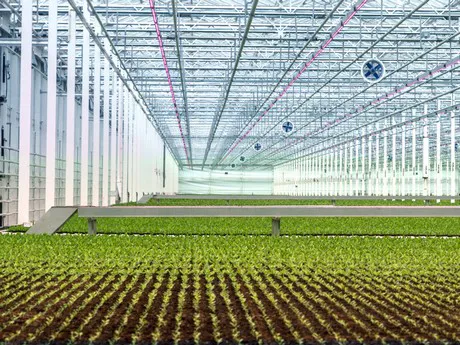Sowing and harvesting every single day, all year round. With high-tech greenhouse innovations, Siberia grows fresh lettuce and bok choy throughout the year. As a result, supermarkets no longer have to import these vegetables in the winter.
In a nine-hectare hydroponic greenhouse, robots and humans work together to grow three types of lettuce and bok choy. Mixing clever water management with the latest automation technology, Siberia supplies supermarket chains and wholesalers in the Netherlands and Europe year round.
Jelle van Dijck is Siberia’s Cultivation and Technology Manager. His father is a director of Siberia’s sister company, Van Dijck Groenteproducties, which stems from the vegetable growing and packing business his grandfather started.
Van Dijck explains how his ultra-modern greenhouse is able to produce fresh lettuce across all four seasons.

How is Siberia different?
Every day, we sow lettuce and bok choy. We plant the seeds in potting soil in a ‘cultivation gutter,’ a kind of long plastic tube with water flowing through it. Once the plants have grown and need more space, they are moved to a new gutter.
Other leaf and lettuce growers place the plants at intervals in the ground. We plant all the little ones together and move them as soon as necessary, making optimum use of the space.
The plants are moved twice: from a gutter with 192 specimens to a gutter with 96, and finally to one with 48. After that we harvest them.
What problem are you solving?
Customers demand sustainable cultivation. In the summer, we use the sun. As the days get shorter, our LED lights go on to extend the daylight hours. This allows us to grow throughout the year, so it’s no longer necessary to import these vegetables from southern Europe.
We use fewer crop-protection products because we can intervene quickly. We’re also able to adjust our production every day, so that we never over-produce. And we ensure that we make clear agreements with customers, so we know exactly what they need. Moreover, we only harvest when we receive an order.
In addition to all this, we use only rainwater, which we collect ourselves. The water circulates throughout the company. It flows through the gutter, and we catch it again at the end. We have our own water purification plant, so we don’t release any artificial fertilizers or pesticides.
What’s your biggest challenge?
It’s becoming increasingly difficult to find people who like working in a greenhouse. That’s why we’ve automated a lot of the work. Six people now operate five robots, which move the plants from one cultivation gutter to another. But the harvest itself remains human work. It’s too costly to automate that part of the process. The flesh-and-blood labor force can also check the quality one last time.
Vegetables awaiting harvest are taken from the greenhouse to the shed. This means that our employees don’t have to work inside the warm greenhouse and can harvest the plants standing up. That’s why we’re able to find staff to do the harvesting, which is much more difficult in companies where people have to work on their knees.
What further developments can we expect?
I expect we’ll grow more vegetables in this way. As a result, we’ll not only have produce throughout the year, but we’ll also ensure more consistent quality.
The weather is getting more and more extreme and in the greenhouse you can regulate the climate. If it’s too hot we close the screens, and if it’s freezing we can increase the heating. We don’t suffer from hail or snow. By growing in the greenhouse, you can manage things better and always deliver.
Source: Rabobank
